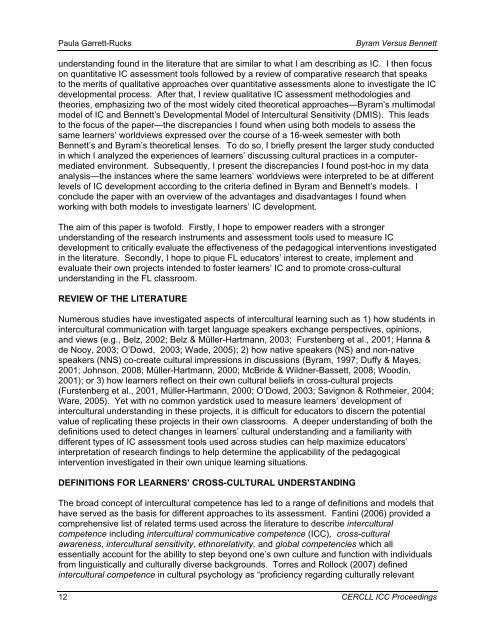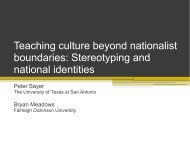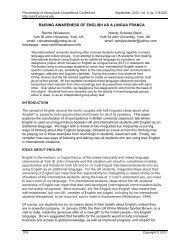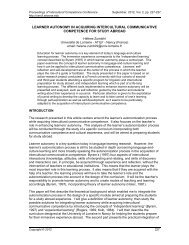BYRAM VERSUS BENNETT: DISCREPANCIES IN THE ... - CERCLL
BYRAM VERSUS BENNETT: DISCREPANCIES IN THE ... - CERCLL
BYRAM VERSUS BENNETT: DISCREPANCIES IN THE ... - CERCLL
You also want an ePaper? Increase the reach of your titles
YUMPU automatically turns print PDFs into web optimized ePapers that Google loves.
Paula Garrett-Rucks Byram Versus Bennett<br />
understanding found in the literature that are similar to what I am describing as IC. I then focus<br />
on quantitative IC assessment tools followed by a review of comparative research that speaks<br />
to the merits of qualitative approaches over quantitative assessments alone to investigate the IC<br />
developmental process. After that, I review qualitative IC assessment methodologies and<br />
theories, emphasizing two of the most widely cited theoretical approaches—Byram’s multimodal<br />
model of IC and Bennett’s Developmental Model of Intercultural Sensitivity (DMIS). This leads<br />
to the focus of the paper—the discrepancies I found when using both models to assess the<br />
same learners’ worldviews expressed over the course of a 16-week semester with both<br />
Bennett’s and Byram’s theoretical lenses. To do so, I briefly present the larger study conducted<br />
in which I analyzed the experiences of learners’ discussing cultural practices in a computermediated<br />
environment. Subsequently, I present the discrepancies I found post-hoc in my data<br />
analysis—the instances where the same learners’ worldviews were interpreted to be at different<br />
levels of IC development according to the criteria defined in Byram and Bennett’s models. I<br />
conclude the paper with an overview of the advantages and disadvantages I found when<br />
working with both models to investigate learners’ IC development.<br />
The aim of this paper is twofold. Firstly, I hope to empower readers with a stronger<br />
understanding of the research instruments and assessment tools used to measure IC<br />
development to critically evaluate the effectiveness of the pedagogical interventions investigated<br />
in the literature. Secondly, I hope to pique FL educators’ interest to create, implement and<br />
evaluate their own projects intended to foster learners’ IC and to promote cross-cultural<br />
understanding in the FL classroom.<br />
REVIEW OF <strong>THE</strong> LITERATURE<br />
Numerous studies have investigated aspects of intercultural learning such as 1) how students in<br />
intercultural communication with target language speakers exchange perspectives, opinions,<br />
and views (e.g., Belz, 2002; Belz & Müller-Hartmann, 2003; Furstenberg et al., 2001; Hanna &<br />
de Nooy, 2003; O’Dowd, 2003; Wade, 2005); 2) how native speakers (NS) and non-native<br />
speakers (NNS) co-create cultural impressions in discussions (Byram, 1997; Duffy & Mayes,<br />
2001; Johnson, 2008; Müller-Hartmann, 2000; McBride & Wildner-Bassett, 2008; Woodin,<br />
2001); or 3) how learners reflect on their own cultural beliefs in cross-cultural projects<br />
(Furstenberg et al., 2001, Müller-Hartmann, 2000; O’Dowd, 2003; Savignon & Rothmeier, 2004;<br />
Ware, 2005). Yet with no common yardstick used to measure learners’ development of<br />
intercultural understanding in these projects, it is difficult for educators to discern the potential<br />
value of replicating these projects in their own classrooms. A deeper understanding of both the<br />
definitions used to detect changes in learners’ cultural understanding and a familiarity with<br />
different types of IC assessment tools used across studies can help maximize educators’<br />
interpretation of research findings to help determine the applicability of the pedagogical<br />
intervention investigated in their own unique learning situations.<br />
DEF<strong>IN</strong>ITIONS FOR LEARNERS’ CROSS-CULTURAL UNDERSTAND<strong>IN</strong>G<br />
The broad concept of intercultural competence has led to a range of definitions and models that<br />
have served as the basis for different approaches to its assessment. Fantini (2006) provided a<br />
comprehensive list of related terms used across the literature to describe intercultural<br />
competence including intercultural communicative competence (ICC), cross-cultural<br />
awareness, intercultural sensitivity, ethnorelativity, and global competencies which all<br />
essentially account for the ability to step beyond one’s own culture and function with individuals<br />
from linguistically and culturally diverse backgrounds. Torres and Rollock (2007) defined<br />
intercultural competence in cultural psychology as “proficiency regarding culturally relevant<br />
12 <strong>CERCLL</strong> ICC Proceedings





